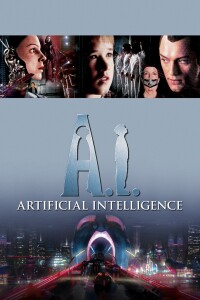A.I. combines a bittersweet fairy tale (in the style of Hans Christian Anderson, not the Brothers Grimm) with an SF story set in a high-tech America of the future. The story also combines the dark, satirical edge of Stanley Kubrick with the sweet wistfulness of Steven Spielberg.
The film sets a plucky little robot, David, on a hero’s journey. During the course of David’s quest, the film examines the nature of humanity. What does it mean to be human? Is it having the right DNA? The ability to feel emotions? The ability to dream and imagine? The ability to die?
The film begins with a cinematic cliché. Dr. Hobby (William Hurt), the brilliant scientist, explains his bold new work to a lecture room full of his peers. It’s plot device Spielberg has used before – remember Indiana Jones’ lecture on the Ark of the Covenant in Raiders of the Lost Ark? It’s also a device that has been used in millions of horror movies including a brilliant parody in Young Frankenstein. Though beginning a film with a lecture is risky – lectures being inherently static and not normally the stuff of high drama – the scene does set up the story and gives the audience the scientific facts needed to understand the conflict.
Dr. Hobby announces that he has created a child robot or “mecha” that has the ability to feel human emotions including genuine love. A colleague asks him a moral question, “If a robot could genuinely love a person, what responsibility does that person hold toward that mecha in return?” Dr. Hobby, who obviously hasn’t seen all those old movies where a scientist compares himself to God and suffers a tragic downfall, responds “Didn’t God create Adam to love him?”
The story then focuses on David (Haley Joel Osment), the child “mecha” who has been created with special features. Unlike other robots, David has emotions and an imagination that develop as the story progresses. He is the first robot made in the likeness of a child, and as part of his beta testing he is placed with Monica (Frances Connor) and Henry Swinton (Sam Robards), a couple whose only son, Martin, has an incurable illness and has been cryogenically frozen for years with no hope of recovery.
Monica activates the little mecha’s bonding feature and from that time on, David is doomed to love her forever. Son Martin, however, has a miraculous recovery and returns home. Bratty, clever Martin (imagine Dennis the Menace with a severe case of sibling rivalry) manipulates his parents into getting rid of his rival. Monica intends to take David back to the factory to be scrapped but finds she cannot do it. Monica and David enact a situation found in thousands of fairy tales: a kind but spineless parent abandons a beloved child in the woods to mollify a jealous spouse or stepchild.
The forest that David and “Teddy,” David’s teddy bear robot and wise mentor, enter into is full of the outsized dangers and opportunities that are the hallmarks of enchanted fairy tale forests. Inspired by the tale of Pinocchio, David reasons that Monica will love him and welcome him home if he becomes a real live boy. Therefore, he embarks on a quest to find the Blue Fairy who can make his wish come true.
David’s quest involves a series of adventures and locales that are a blend of fairy tale and sci-fi elements. Befriended by the sex worker mecha Gigolo Joe, (Jude Law), whose graceful movements blend Gene Kelly and the Tin Man in the Wizard of Oz, David travels through a magical, terrible landscape that includes beautifully realized futuristic locales such as The Flesh Fair, Rouge City (Tokyo meets the Emerald City on speed), and New York after global warming has caused it to be submerged. Allusions to fairy tales, ancient and modern, abound. When the doctor tells Monica and Henry that medical science can’t bring their son, Martin, out of his coma, there is a shot of a mural on the wall behind his head which depicts the story of the “emperor who had no clothes.” This serves to cast doubt on the doctor’s opinion and foreshadows Martin’s remarkable recovery. Later, David, like Dorothy in The Wizard of Oz, must produce a talisman to bring him home, and also like Dorothy, he doesn’t realize he’s had it with him since the beginning of his adventure.
In his search for Mom and home, David is forced to develop his imagination. Ironically, David, who was turned out of his home and nearly destroyed for not being human, is considered the exemplar of humanity by the aliens who rescue him. Like Pinocchio or Anderson’s “Little Mermaid,” David gains his soul through suffering and becomes truly human. He is transformed into a real boy who experiences love, loss, terror and finally death.
A.I. is an ironic fairy tale with a scorpion’s sting in its tail. The hero’s wise mentor is an automated teddy bear whose good advice has absolutely no effect on the course of events. David’s hero’s journey is futile; it ends in a frozen world devoid of life. Even the good aliens who stand in for fairy godmothers cannot alter the tragedy that has befallen David; they can only sweeten it a little.
Does the blending of Kubrick and Spielberg work? I say yes. Kubrick’s influence adds an edge to the film, keeps it from getting all soft, and sticky and sentimental as Spielberg’s films often do. Spielberg, on the other hand, tends to curb Kubrick’s tendency to produce films that are all cold and clinical observation, lacking heart. The result is a rare combination of exactitude and soul.
(Universal Studios, 2001)

